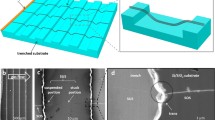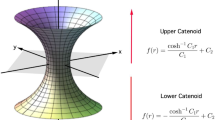Abstract
In this research article, we analyze phonon scattering in branched single-walled carbon nanotube (SWCNT) networks with SWCNT–SWCNT T- and X- junctions using the wave packet method. Five phonon branches including the longitudinal acoustic, twisting, transverse acoustic, radial breathing, and flexural optical modes are selected to study energy reflection, ramification, and transmission through T- and X-junctions with (6,6) and (4,4) SWCNTs. The results of the simulations indicate that the diameter of SWCNTs affects phonon scattering at carbon nanotube junctions; T-junctions of (6,6) SWCNTs transmit energy more efficiently when compared to T-junctions with (4,4) SWCNTs. In addition, T-junctions of both (6,6) and (4,4) SWCNTs transmit vibrational energy more efficiently when compared to X-junctions in the same phonon frequency range—for example, in the case of the longitudinal acoustic branch, the average energy transmission at T-junctions for low-frequency phonons (lower than 6 THz) was found to be 1.8–2.4 times higher [for the case of (6.6) and (4,4) SWCNTs, respectively] when compared to the X-junctions. It is also observed that energy transmission at the T-junctions shows a dependency on the phonon group velocity with the higher group velocity phonons showing higher energy transmission; however, for the case of the X-junctions, there is little or no correlation observed between the group velocity and energy transmission indicating a complete energy redistribution of the incoming phonons at the junction. Moreover, for the SWCNT–SWCNT branched networks, the energy ramification at the T-junctions was found to be very similar to that at the X-junctions for both (6,6) and (4,4) SWCNTs indicating transverse thermal transport at the X-junctions to be as efficient as the T-junctions.







Similar content being viewed by others
References
Alfè D (2009) PHON: a program to calculate phonons using the small displacement method. Comput Phys Commun 180:2622–2633
Andriotis AN, Menon M, Srivastava D, Chernozatonskii L (2001) Rectification properties of carbon nanotube “Y-Junctions”. Phys Rev Lett 87:066802
Andriotis AN, Menon M, Srivastava D, Chernozatonskii L (2002) Transport properties of single-wall carbon nanotube Y junctions. Phys Rev B 65:165416
Berber S, Kwon Y-K, Tomanek D (2000) Unusually high thermal conductivity of carbon nanotubes. Phys Rev Lett 84:4613
Bifano MF, Park J, Kaul PB, Roy AK, Prakash V (2012) Effects of heat treatment and contact resistance on the thermal conductivity of individual multiwalled carbon nanotubes using a Wollaston wire thermal probe. J Appl Phys 111:054321
Cummings A, Osman M, Srivastava D, Menon M (2004) Thermal conductivity of Y-junction carbon nanotubes. Phys Rev B 70:115405
Do J-W, Estrada D, Xie X, Chang NN, Mallek J, Girolami GS, Rogers JA, Pop E, Lyding JW (2013) Nanosoldering carbon nanotube junctions by local chemical vapor deposition for improved device performance. Nano Lett 13:5844–5850
Donadio D, Galli G (2007) Thermal conductivity of isolated and interacting carbon nanotubes: comparing results from molecular dynamics and the Boltzmann transport equation. Phys Rev Lett 99:255502
Dove MT (1993) Introduction to lattice dynamics, vol 4. Cambridge university press, Cambridge
Ho G, Wee A, Lin J (2001) Electric field-induced carbon nanotube junction formation. Appl Phys Lett 79:260–262
Kaul PB, Bifano MFP, Prakash V (2013) Multifunctional CNT-Epoxy composite for thermal energy management. J Compos Mater 47:77–95
Lee J, Varshney V, Roy AK, Farmer BL (2011) Single mode phonon energy transmission in functionalized carbon nanotubes. J Chem Phys 135:104109
Lee J, Varshney V, Brown JS, Roy AK, Farmer BL (2012) Single mode phonon scattering at carbon nanotube-graphene junction in pillared graphene structure. Appl Phys Lett 100:183111–183114
Li J, Papadopoulos C, Xu J (1999) Nanoelectronics: growing Y-junction carbon nanotubes. Nature 402:253–254
Ma J, Alfè D, Michaelides A, Wang E (2009) Stone-Wales defects in graphene and other planar sp2-bonded materials. Phys Rev B 80:033407
Mayhew E, Prakash V (2014) Thermal conductivity of high performance carbon nanotube yarn-like fibers. J Appl Phys 115:174306
Menon M, Srivastava D (1997) Carbon nanotube “T junctions”: nanoscale metal-semiconductor-metal contact devices. Phys Rev Lett 79:4453–4456
Menon M, Srivastava D (1998) Carbon nanotube based molecular electronic devices. J Mater Res 13:2357–2362
Noya EG, Srivastava D, Menon M (2009) Heat-pulse rectification in carbon nanotube Y junctions. Phys Rev B 79:115432
Park J, Prakash V (2013) Thermal transport in 3D pillared SWCNT–graphene nanostructures. J Mater Res 28:940–951
Park J, Prakash V (2014a) Phonon scattering and thermal conductivity of pillared graphene structures with carbon nanotube-graphene intramolecular junctions. J Appl Phys. doi:10.1063/1.4885055
Park J, Prakash V (2014b) Thermal resistance across interfaces comprising dimensionally mismatched carbon nanotube-graphene junctions in 3D carbon nanomaterials. J Nanomater 2014:10. doi:10.1155/2014/679240
Park J, Bifano MF, Prakash V (2013) Sensitivity of thermal conductivity of carbon nanotubes to defect concentrations and heat-treatment. J Appl Phys 113:034311–034312
Plimpton S, Crozier P, Thompson A (2007) LAMMPS-large-scale atomic/molecular massively parallel simulator. Sandia National Laboratories, Albuquerque
Schelling P, Phillpot S, Keblinski P (2002) Phonon wave-packet dynamics at semiconductor interfaces by molecular-dynamics simulation. Appl Phys Lett 80:2484–2486
Sun H (1998) COMPASS: an ab initio force-field optimized for condensed-phase applications overview with details on alkane and benzene compounds. J Phys Chem B 102:7338–7364
Sun H, Mumby SJ, Maple JR, Hagler AT (1994) An ab initio CFF93 all-atom force field for polycarbonates. J Am Chem Soc 116:2978–2987
Sun H, Ren P, Fried J (1998) The COMPASS force field: parameterization and validation for phosphazenes. Comput Theor Polym Sci 8:229–246
Thomas JA, Iutzi RM, McGaughey AJ (2010) Thermal conductivity and phonon transport in empty and water-filled carbon nanotubes. Phys Rev B 81:045413
Varshney V, Patnaik SS, Roy AK, Froudakis G, Farmer BL (2010) Modeling of thermal transport in pillared-graphene architectures. ACS Nano 4:1153–1161
Wang J, Wang JS (2009) Single-mode phonon transmission in symmetry-broken carbon nanotubes: role of phonon symmetries. J Appl Phys 105:063508–063509
Wei Z, Chen Y, Dames C (2012) Wave packet simulations of phonon boundary scattering at graphene edges. J Appl Phys 112:024327–024328
Acknowledgments
This work made use of the High Performance Computing Resource in the Core Facility for Advanced Research Computing at Case Western Reserve University. The authors also would like to acknowledge the support of the Air Force Office of Scientific Research (AFOSR) MURI Grant No. FA9550-12-1-0037 (Program Manager: Dr. Joycelyn Harrison) for conducting this research.
Conflict of interests
The authors declare that there is no conflict of interests regarding the publication of this paper.
Author information
Authors and Affiliations
Corresponding author
Rights and permissions
About this article
Cite this article
Park, J., Lee, J. & Prakash, V. Phonon scattering at SWCNT–SWCNT junctions in branched carbon nanotube networks. J Nanopart Res 17, 59 (2015). https://doi.org/10.1007/s11051-015-2873-0
Received:
Accepted:
Published:
DOI: https://doi.org/10.1007/s11051-015-2873-0




